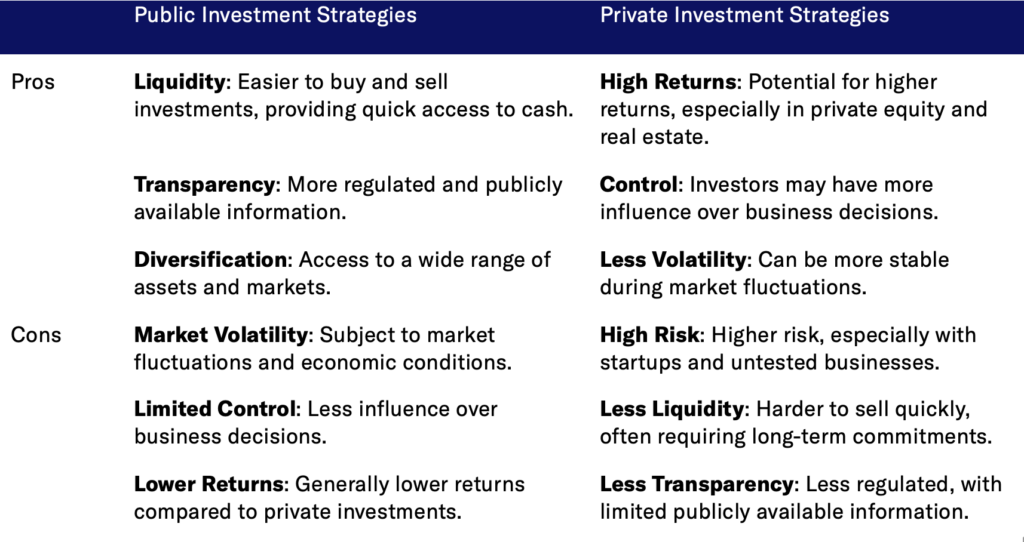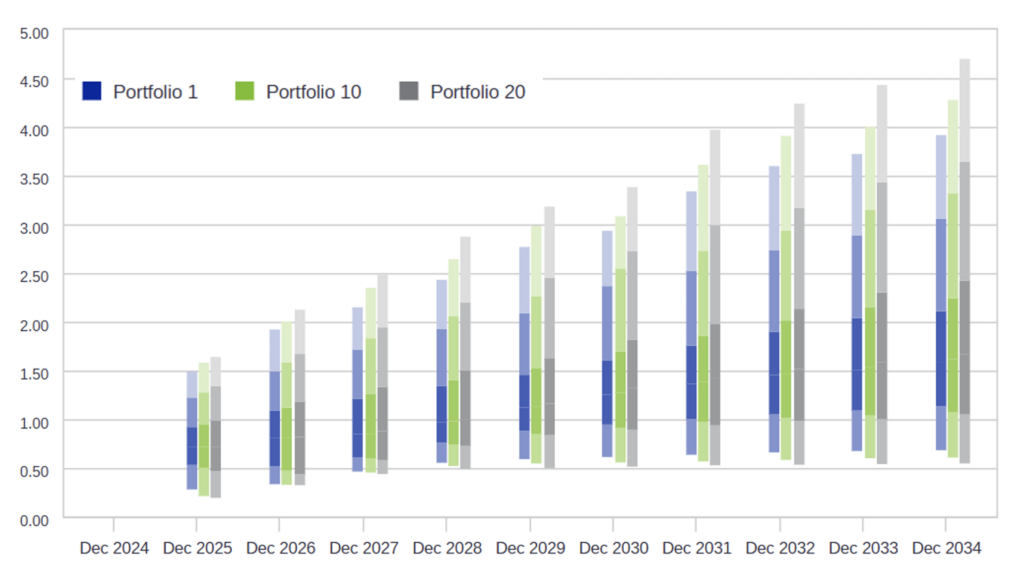Allocation Strategies for Public Pension Plans: Traditional vs. Alternative Investments
INTRODUCTION
Effective asset allocation is crucial for public pension plans to manage market fluctuations and address changes in their liability structures. Conducting comprehensive asset allocation studies helps optimize investment strategies, mitigate risks, and ensure long-term financial stability. By assessing various asset classes and their impacts, public pension plans can make informed decisions aligned with their goals and obligations.
Return-seeking funds drive portfolio returns, primarily through public equity allocations. However, many public pension plans have reduced their public equity allocations to incorporate or increase private equity or other alternative investments within their portfolios seeking higher investment returns. The inclusion of alternative investments, despite their illiquidity and higher fees, is considered advantageous when it performs well. However, if public equity outperforms private equity, it necessitates discussions within boardrooms to reconfirm commitment to the asset class.
FIGURE 1: Contribution to Risk/Return by Portfolio

Utilizing a risk and analytics tool such as PFaroe DB can effectively support these discussions. This platform assists public pension plans in developing, monitoring, and adjusting their strategic asset allocations while ensuring the plan’s risk aligns with their tolerance levels. Fluctuating markets and changing plan structures may complicate allocations; thus, having a readily available tool to assess potential impacts is crucial for future success. Ensuring proper liquidity while achieving optimal investment returns to minimize plan contributions and maintain (or even improve) benefit levels remains a high priority.
A thorough comprehension of the dynamics of both public and private investment strategies enables public pension plans to make informed strategic decisions that are in alignment with their long-term financial objectives and obligations.
PUBLIC EQUITY ALLOCATIONS
Public pension plans invest in public equities due to their liquidity, transparency, and diversification benefits. Public equities can be easily traded to manage cash flow and respond to market changes. Regular financial disclosures provide reliable data for informed decisions. Diversifying across sectors reduces risk and enhances returns.
ALTERNATIVE ASSETS ALLOCATIONS
Public pension plans invest in private equity for higher returns and diversification. Private equity yields better returns through high-growth companies and leveraged buyouts, and offers access to non-public companies, reducing portfolio risk. Investors can influence management for improved performance. Despite higher risks and less liquidity, private equity may suit the long-term goals of pension plans.

ALTERNATIVE ASSETS ALLOCATIONS
Public pension plans have been refining their investment strategies over the years, increasingly incorporating alternative investments such as private assets, hedge funds, real estate, and commodities. This strategic shift aims to diversify portfolios, mitigate risk, and pursue higher returns compared to traditional investments. Some key observations:
- Decrease in Public Equity Investments: Traditionally, public equities were the majority component in pension plan portfolios. However, their share has diminished in the past decade as plan sponsors have increasingly embraced private asset classes.
- Rise in Alternative Investments: Pension plans are diverting funds from traditional equities to alternative investments to diversify and improve returns, aiming for better yields and risk mitigation than conventional stocks and bonds.
- Varied Impact on Returns: The outcomes of this shift towards alternative investments have been mixed. Certain pension plans have experienced improved returns, while others, particularly those invested in hedge funds, have encountered lower returns. The overall effect on returns and volatility is contingent upon the specific composition of alternative assets in the portfolio.
LEVERAGING PFAROE DB FOR STRATEGIC DECISION-MAKING
PFaroe DB assists public pension plans by focusing on assets and/or liabilities, aligning with their allocation strategies. It allows for in-house decision-making, enabling users to manage assets and funding efficiently, aiding strategic decision-making as market conditions and plan structures evolve. PFaroe DB includes optimization tools, Asset Liability Management (ALM) modules for forward-looking projections, stress testing, and risk analytics capabilities. These features enable public pension plans to build more effective portfolios, assess and adjust their asset allocations as markets change to maintain investment returns, and increase efficiency and productivity.
FIGURE 2: Projected Ultimate Net Cost[1] by Portfolio

While historically public pension plan sponsors may have performed long-term asset allocation studies every 3-5 years, given the constant evolution of financial markets, a tool like PFaroe DB allows them to perform these studies more frequently with relative ease to keep up with the latest information available.
[1] Ultimate Net Cost: defined as the sum of Unfunded liability and Cumulative contributions paid.
MAKING THE BEST FINANCIAL DECISIONS FOR PUBLIC PENSION PLANS
To optimize financial decision-making, public pension plans should adopt a balanced strategy that encompasses both private and public equity, offering diversification advantages and reducing overall plan risk. Implementing comprehensive risk management practices to monitor and address potential risks associated with these investment types is crucial. Aligning investment strategies while balancing both the short-term and long-term objectives and obligations of the pension plan is essential. Advanced analytics tools and carefully selected managers for private equity investments can help capture performance gains. Maintaining transparency and robust governance practices will sustain trust among stakeholders.
Conclusion
Market volatility impacting returns can complicate boardroom discussions. Clear communication on strategy, supported by analytics and education for the board, is essential. Both public equity and alternative investments have unique pros and cons. Understanding these differences and adopting strategic practices allows public pension plans to make informed decisions aligned with their long-term goals.




